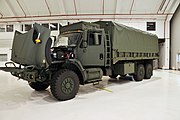
The Canadian Army is the command responsible for the operational readiness of the conventional ground forces of the Canadian Armed Forces. It maintains regular forces units at bases across Canada, and is also responsible for the Army Reserve, the largest component of the Primary Reserve. The Army is headed by the concurrently held Commander of the Canadian Army and Chief of the Army Staff, who is subordinate to the Chief of the Defence Staff. The Army is also supported by 3,000 civilian employees from the civil service.

The Royal Corps of Signals is one of the combat support arms of the British Army. Signals units are among the first into action, providing the battlefield communications and information systems essential to all operations. Royal Signals units provide the full telecommunications infrastructure for the Army wherever they operate in the world. The Corps has its own engineers, logistics experts and systems operators to run radio and area networks in the field. It is responsible for installing, maintaining and operating all types of telecommunications equipment and information systems, providing command support to commanders and their headquarters, and conducting electronic warfare against enemy communications.

The Canadian Grenadier Guards (CGG) is a reserve infantry regiment in the 34 Canadian Brigade Group, 2nd Canadian Division, of the Canadian Army. The regiment is the oldest and second-most-senior infantry regiment in the Primary Reserve of the Canadian Army. Located in Montreal, its primary role is the provision of combat-ready light infantry troops in support of Canadian regular infantry. It is a Household Foot Guard regiment and also provides soldiers for public ceremonial duties, performing similar ceremonial duties to the Guards regiments of the British Army. This primarily entails mounting the guard on Government House, the Governor General's residence, and performing the "Changing the Guard" ceremony on Parliament Hill in Ottawa, a task it shares with Canada's senior Household Foot Guard regiment, the Governor General's Foot Guards of Ottawa. The Canadian Grenadier Guards is an allied regiment to the British Grenadier Guards.
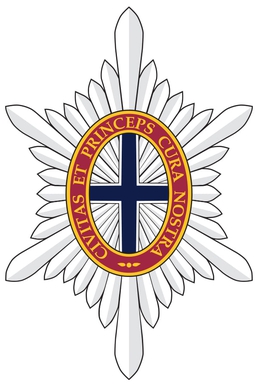
The Governor General's Foot Guards (GGFG) is the senior reserve infantry regiment in the Canadian Army. Located in Ottawa at the Cartier Square Drill Hall, the regiment is a Primary Reserve infantry unit, and the members are part-time soldiers.
The Royal Canadian Corps of Signals is a component within the Canadian Armed Forces' Communications and Electronics Branch, consisting of all members of that personnel branch who wear army uniform. Prior to 1968 it was a combat support corps of the Canadian Army. The Royal Canadian Corps of Signals was re-instituted in 2013. It provides communication support and information systems for the Canadian Army.
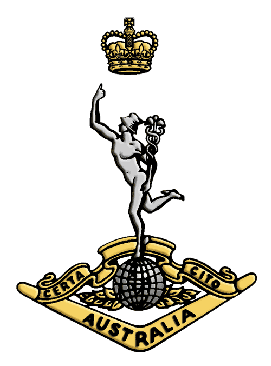
The Royal Australian Corps of Signals (RASigs) is one of the 'arms' of the Australian Army. It is responsible for installing, maintaining, and operating all types of telecommunications equipment and information systems. The motto of the Signals Corps is Certa Cito and is translated as 'Swift and Sure', signifying the aim of the signal service – that communication be carried out with maximum speed and certainty. Like their British counterparts, the Royal Australian Corps of Signals' flag and hat badge feature Mercury, the winged messenger of the gods, affectionately referred to by members of the corps as "Jimmy".
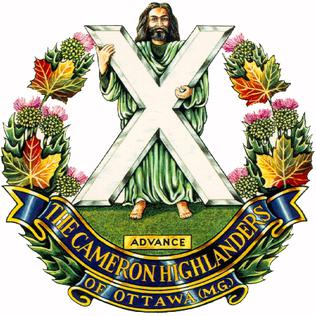
The Cameron Highlanders of Ottawa (Duke of Edinburgh's Own) is a Canadian Army Primary Reserve infantry regiment.
Bowman is the name of the tactical communications system used by the British Armed Forces.

The Communications and Electronics Branch is a personnel branch of the Canadian Armed Forces (CAF). The army component of the branch is designated the Royal Canadian Corps of Signals.

The Primary Reserve of the Canadian Armed Forces is the first and largest of the four sub-components of the Canadian Armed Forces reserves, followed by the Supplementary Reserve, the Cadet Organizations Administration and Training Service and the Canadian Rangers.

The AN/PRC-148 Multiband Inter/Intra Team Radio (MBITR) is the most widely fielded handheld multiband, tactical software-defined radio, used by NATO forces around the world. The radio is built by Thales Communications, a subsidiary of the France-based Thales Group. The designation AN/PRC translates to Army/Navy Portable Radio used for two way Communications, according to Joint Electronics Type Designation System guidelines.
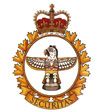
2 Military Police Regiment is a unit of the Canadian Forces. It provides support to the Canadian Army within the Province of Ontario. It does not provide support to Canadian Forces Bases Borden, Trenton and North Bay and Canadian Forces Support Unit (Ottawa). The unit was initially created in the summer of 2006. Since then, the unit was officially established by a ministerial organization order (MOO) and a Canadian Forces organization order (CFOO) dated September 24, 2007. It is a "total force" unit of the Canadian Army Military Police Group (CA MP Gp). The term total force describes a unit which includes both Regular Force and Reserve Force members. 2 MP Regt is responsible for police, security and detention operations as well as police support in field operations. The unit headquarters is located at the George Taylor Denison III Armoury, more commonly known as Denison Armoury, in Toronto, Ontario. The strength of 2 MP Regt totals just under 300 personnel. Since the transfer of command authority (TOCA) on 1 April 2011, 2 MP Regt is under the full command of the Canadian Forces Military Police Group through the CA MP Gp, and attached operational command (OPCOM) to the 4th Canadian Division. The unit is commanded by a major as the commanding officer (CO) and the unit has a master warrant officer who is the regimental sergeant major (RSM). The CO of 2 MP Regt reports directly to the commander of the CA MP Gp, as well as the commander of 4 Cdn Div. The CO has a dual function as commanding officer and division provost marshal.
The Royal Signals trades are the employment specialisations of the Royal Corps of Signals in the British Army. Every soldier in the Corps is trained both as a field soldier and a tradesman. There are currently six different trades, all of which is open to both men and women:
The British Armed Forces operates a wide range of communications and information systems. Some of these are specialised military systems, while others are procured off-the-shelf. They fall into three main categories: satellite ground terminals, terrestrial trunk communications systems, and combat net radio systems. Every part of the Army and the uses combat net radio, but only the Royal Corps of Signals and the Royal Air Force operates trunk systems and multi-channel satellite communications.

Fort York Armoury is a Canadian Forces facility located near the grounds of the Canadian National Exhibition in Toronto, Ontario, Canada. It is located at the intersection of Fleet Street and Fort York Boulevard, close to the historic Old Fort York in the neighbourhood of Fort York. It currently hosts several units of the Primary Reserve and the Canadian Cadet Organization.
36 Signal Regiment is Reserve unit of the Canadian Army, assigned to 36 Canadian Brigade Group. It was created on 1 April 2012 after several years of planning.
The following is a hierarchical outline for the Canadian Armed Forces at the end of the Cold War. It is intended to convey the connections and relationships between units and formations.

39 Signal Regiment, formerly known as 744 Signal Regiment in Vancouver, 741 Signal Squadron in Esquimalt and 748 Signal Squadron in Nanaimo, is a Primary Reserve Canadian Army unit of the Royal Canadian Corps of Signals in Vancouver, Victoria and Nanaimo, British Columbia.

The Signal Corps of the French Army, is the military administrative corps which specialises in military communications and communications and information systems (CIS).
The Iris Digital Communications System, also known as the Tactical Command, Control, and Communications System (TCCCS), is a tactical communication system used by the Canadian Army. It was a pioneering system that integrated voice and data communications via the Internet Protocol and ST-II protocol. Elements of the Iris system, together with the High-capacity data radio, later formed the foundation of the British Army's Bowman communications system.



